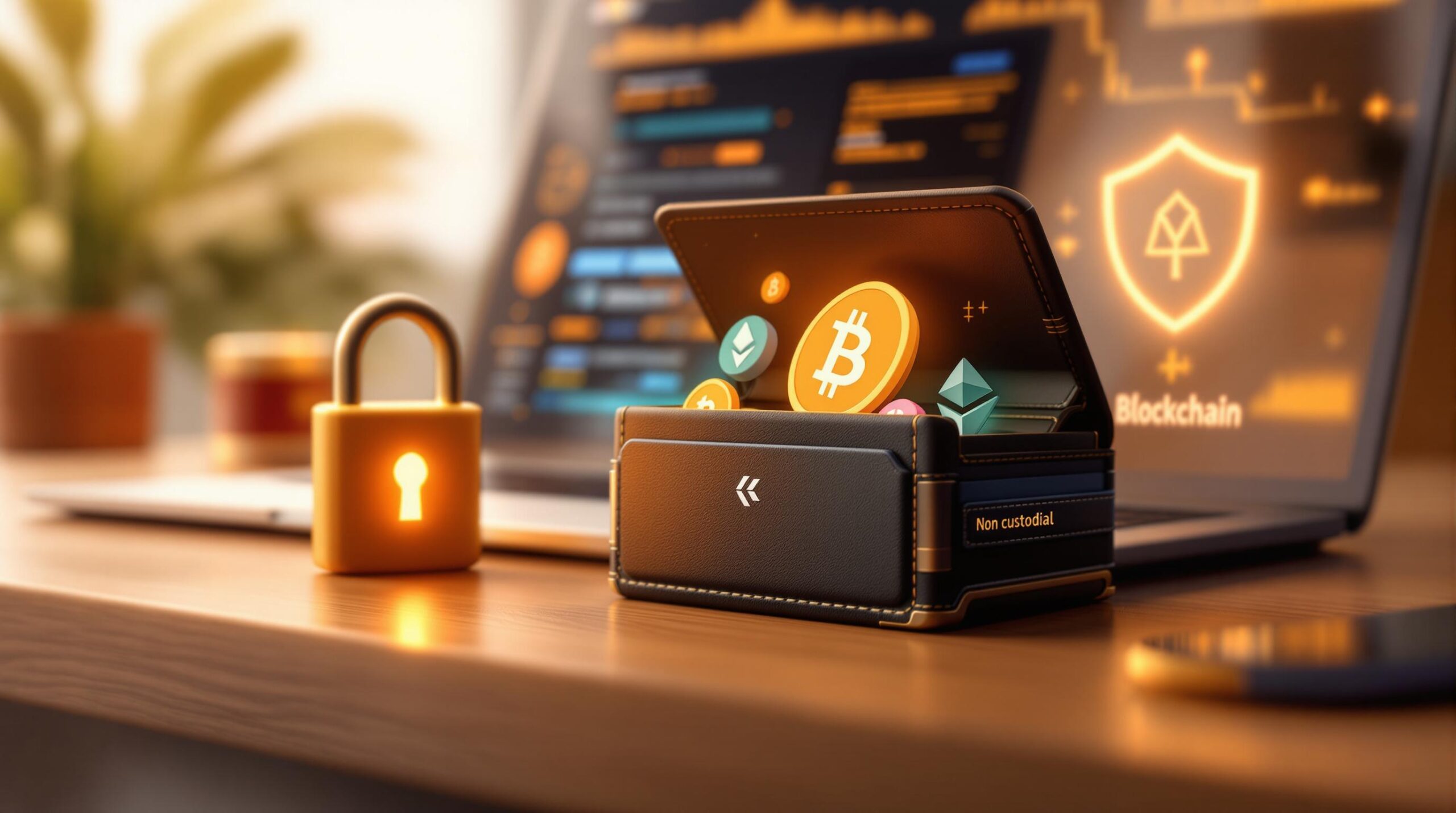Non-custodial wallets give you full control over your crypto assets by letting you manage your private keys directly. But with great control comes great responsibility – and risks. Here’s what you need to know:
- Main Risks: Losing private keys (20% of Bitcoin is permanently lost), phishing scams, and network vulnerabilities like public WiFi attacks.
- Key Security Tips: Use hardware wallets, keep encrypted backups, and avoid unaudited smart contracts.
- Advanced Solutions: Multi-signature wallets, machine-learning transaction verification, and quantum-resistant cryptography are tackling modern threats.
- High-Leverage Trading: Platforms like Defx combine Ethereum and Solana for secure, high-speed transactions while using advanced risk monitoring.
Want to keep your crypto safe? Focus on private key management, secure storage, and advanced authentication methods.
Crypto Wallets Explained: Security Guide
Main Security Risks
Non-custodial wallets come with several serious security challenges that users need to be aware of to safeguard their assets.
Private Key Security
Managing private keys is the cornerstone of wallet security. Did you know that roughly 20% of Bitcoin’s total supply – valued at around $140 billion – is permanently lost due to misplaced private keys? [1][4]. Even hardware wallet companies report that 12-18% of their support tickets involve users who can no longer access their funds [5].
Here are some common vulnerabilities tied to private keys:
| Vulnerability | Risk Profile |
|---|---|
| Unencrypted Storage | High risk of theft (23% of losses) |
| Missing Recovery Phrase | Permanent loss of access (15% of users) |
| Weak Passwords | Susceptible to brute-force attacks (40% of breaches) |
Social Engineering Threats
Social engineering attacks are becoming more advanced. In one case, scammers posed as MetaMask support staff and tricked users into revealing their seed phrases during fake troubleshooting sessions [6][4].
Smart Contract Risks
The $600 million Poly Network hack highlighted how vulnerabilities in contract approvals can bypass wallet security. Using unaudited contracts increases the risk of exploitation by 73% [9].
Network Security Issues
Public WiFi networks are a major weak spot. Users making transactions on these networks face a 40% higher chance of interception attacks [5]. These attacks can:
Given these challenges, having strong authentication systems is more important than ever. The next section will dive into effective security frameworks designed to tackle these issues.
Security Tools and Methods
Addressing modern security challenges requires a multi-layered approach that combines hardware, cryptographic protocols, and behavioral analysis. Current frameworks focus on three main areas: secure storage, transaction verification, and user authentication.
Key Storage Protection
Private key storage has advanced significantly, with systems now using secure element chips and high-level encryption to safeguard keys. These chips ensure private keys remain in tamper-resistant environments, allowing for secure, offline transactions [1].
| Security Method | Protection Level | Key Features |
|---|---|---|
| Hardware Wallets | Very High | Offline storage, secure element technology |
| Multi-signature | High | Approval thresholds, multiple key holders |
Safe Transaction Signing
Transaction security has moved beyond simple verification. Tools like De.Fi Scanner now use machine learning to review smart contracts before execution, identifying over 57 risk patterns [2].
"Sandboxed environment testing with 98% accuracy in threat detection, allowing users to verify transaction outcomes before committing to the blockchain" [4].
This proactive approach ensures users can detect and avoid potential threats before completing any blockchain transactions.
User Authentication Systems
Securing user accounts is equally important. Advanced systems like BioCatch focus on behavioral patterns to detect unauthorized access. By analyzing factors such as:
- Keystroke dynamics
- Mouse movement patterns
- Device handling habits
BioCatch has managed to cut account takeover risks by 83%, as measured against NIST IR 8374 standards [4]. This method offers a more reliable alternative to traditional SMS-based two-factor authentication.
sbb-itb-dd9e24a
High-Leverage Trading Security
High-leverage trading platforms need advanced security systems that safeguard users’ assets without compromising trading speed. Modern platforms achieve this by combining various blockchain technologies to strike the right balance.
Defx Security Structure

Defx uses a dual-chain architecture to combine the strengths of different blockchains. Ethereum’s reliable smart contracts handle secure fund management, while Solana’s high-speed processing (65,000 transactions per second) ensures fast order execution [10].
| Security Layer | Implementation | Benefit |
|---|---|---|
| Order Execution | Solana processing | Reduces settlement delays |
The platform employs Byzantine Fault-Tolerant consensus and encrypts transaction data in mempools to block front-running in high-frequency trades. Solana’s Proof-of-History system enables 400ms order matching, removing timing-related vulnerabilities [10].
Security-First Trading Features
For cross-margin trading, Defx uses isolated smart contract vaults with strict permission controls. This setup addresses potential risks in contract approvals, as highlighted in Section 2. Additionally, tiered liquidation buffers adjust automatically based on leverage levels:
"The platform implements tiered liquidation buffers (15% for 50x positions vs 5% standard) and real-time volatility monitoring that automatically reduces allowable leverage during market turbulence" [10].
In pre-launch token markets, Defx applies strict measures like mandatory CertiK audits and liquidity locks, enforced through time-delayed contracts. Decentralized oracle networks with data from at least seven sources ensure reliable information [2][8].
To enhance position security, the platform uses automatic wallet rotation protocols. These protocols generate new deposit addresses for remaining collateral, inspired by hardware wallet principles [11]. Combined with multi-party computation signatures, this approach ensures private keys remain secure during margin operations [10].
Defx also employs a real-time risk monitoring system to protect against network interception. This system continuously evaluates collateral health using decentralized price feeds, ensuring leveraged positions remain secure.
Next-Gen Wallet Security
As digital threats evolve, wallet providers are stepping up with new technologies to tackle future challenges head-on.
Quantum Security Measures
Quantum computing is set to disrupt traditional cryptographic methods. A 2024 IBM study predicts that machines with over 1 million qubits could break 256-bit elliptic curve cryptography (ECC) by 2030 [4]. To counter this, wallet providers are turning to quantum-resistant cryptography.
Ledger, for example, has incorporated XMSS quantum-resistant signatures into its hardware wallets. Charles Guillemet, their Chief Security Officer, spearheaded this effort to safeguard user assets against quantum-based attacks [1]. Key features of their approach include:
- Lattice-based key generation
- Hash-based signature verification
- Backward-compatible migration options
These measures work alongside AI systems to provide a robust defense against potential threats.
AI Security Systems
AI-driven security tools are proving highly effective in preventing breaches and fraudulent activities. Fireblocks, for instance, uses an AI engine that analyzes device biometrics and transaction context to block unauthorized access. This is particularly useful against social engineering tactics, as discussed earlier in Section 2.2 [4][5].
Machine learning models used in this space evaluate over 50 transaction parameters, achieving 92% accuracy in identifying suspicious activities, according to 2023 MITRE testing [4].
Zero-Knowledge Security
Zero-knowledge proofs (zk-proofs) enhance security by concealing sensitive transaction details, reducing vulnerabilities during smart contract interactions (see Section 2.3). zk-STARKs, for example, enable private DeFi operations while still allowing for full auditability [4][8].
Trezor has adopted Monero’s Seraphis protocol, which offers selective disclosure through auditor keys while keeping privacy as the default. This approach reduces on-chain data exposure by 78% compared to transparent transactions [4][8].
Conclusion
Security Guidelines
The security measures outlined in this article aim to establish a strong defense system for non-custodial wallets. With 68% of crypto losses caused by user errors, as noted in Section 2.1 (Private Key Security) [1][5], hardware solutions and AI monitoring tools are crucial. Hardware wallets, for instance, can reduce the attack surface by 89% [1].
To enhance security, users should:
- Keep multiple encrypted backups
- Employ hardware security modules
- Adopt transaction verification techniques from Section 3.2 [1][3][5]
Platform Security Standards
Modern trading platforms are now equipped with advanced security frameworks. For example, Defx leverages Ethereum’s reliable smart contracts and Solana’s high-speed infrastructure to ensure secure order execution [10].
| Security Measure | Implementation | Benefit |
|---|---|---|
| Real-time Monitoring | 50ms block time verification | Immediate threat detection |
Authentication methods like Multi-Party Computation (MPC) wallets and biometric hardware signatures, discussed in Section 3.3, complement these platform features to create a secure environment [3][4]. By combining user practices from Section 2 with these advanced tools, non-custodial wallets can strike a balance between security and ease of use for managing cryptocurrency.
